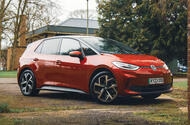Why Isn’t Volkswagen Calling the Updated ID 3 the ID Golf?
If you’ve been following Volkswagen’s electric journey, you might’ve wondered why the brand’s popular ID 3 isn’t simply being rebranded as the ID Golf. After all, the Golf is one of VW’s most iconic names, and the ID 3 is its closest electric counterpart. So, what’s behind this naming decision? According to Volkswagen CEO Thomas Schäfer, it’s all about staying true to the DNA of their classic models.
Volkswagen’s approach is refreshingly honest: they’ll only give an electric vehicle a classic name if it genuinely fits the spirit and character of the original. Schäfer points out that slapping a legendary badge on a car that doesn’t embody what made the original special would be a misstep. It’s a philosophy rooted in respect for both the brand’s heritage and its customers’ expectations.
What’s Changing in the Next-Gen ID 3?
The ID 3 is about to get a significant overhaul, and Volkswagen isn’t holding back. Both the ID 3 and its sibling, the ID 4, are moving onto the upgraded MEB Plus platform. This means improved range, faster charging, and a more refined driving experience—key factors for anyone considering an EV today.
But the real story is inside the cabin. Early versions of the ID 3 faced criticism for their hard plastic interiors, which felt a bit underwhelming for a car in this segment. Volkswagen listened. The initial facelift already addressed some of these concerns, but the upcoming update promises a completely new interior. Expect higher-quality materials, smarter tech integration, and a more inviting atmosphere overall. Schäfer himself teased that the changes are substantial, hinting that the new ID 3 will feel like a whole new car without actually being one.
How Does Volkswagen Decide Which Classic Names to Use for EVs?
Naming a car isn’t just about marketing—it’s about identity. Volkswagen’s strategy is to use classic names like Polo, Golf, or Tiguan only when the new model truly lives up to the legacy. For example, the upcoming ID Polo is being called just that because it matches the proportions, look, and feel of the original Polo. The same goes for the ID Tiguan, which is reportedly the internal name for the next-gen ID 4.
Schäfer is clear: if a new EV doesn’t fit the mold of its namesake, it won’t get the badge. This careful approach helps avoid confusion, especially as VW’s lineup transitions from internal combustion engines to electric power. It also ensures that the emotional connection drivers have with names like Golf or GTI remains intact.
Why Does This Naming Strategy Matter for Drivers?
For many car buyers, a name is more than just a label—it’s a promise. Calling a car “Golf” sets certain expectations for handling, practicality, and even nostalgia. If the driving experience doesn’t match up, it can feel like a letdown. Volkswagen’s refusal to force classic names onto new EVs shows a rare commitment to authenticity in an industry where badge engineering is all too common.
This approach also makes the transition to electric vehicles less jarring for loyal customers. By reserving iconic names for models that truly deserve them, VW is building trust and making it easier for traditional drivers to embrace the future.
What Can We Expect from Volkswagen’s Electric Lineup Going Forward?
Looking ahead, Volkswagen plans to roll out more electric models with classic names, but only when it makes sense. Schäfer promises that as new models or major updates arrive, familiar badges will return—provided the cars live up to their heritage. If not, VW has a deep bench of names, both old and new, to draw from.
This strategy isn’t just about nostalgia; it’s about clarity. As the brand navigates the tricky transition from gasoline to electric, clear and honest naming helps customers understand what they’re getting. It’s a move that could set a new standard for the industry.
The Bottom Line: Respecting Heritage While Embracing Change
Volkswagen’s decision not to call the updated ID 3 the ID Golf is more than a branding choice—it’s a statement about values. By insisting that names reflect the true character of a car, VW is showing respect for its past while building credibility for its electric future. For drivers, that means you can trust that when you see a classic badge on a new VW, it’s there for a reason. And as the electric revolution picks up speed, that kind of authenticity is more important than ever.

